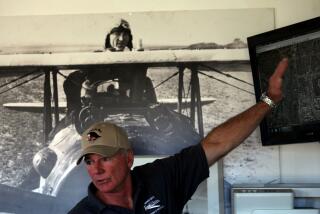Ill-Fated Balloonists Shared Passion for Flying : Belarus: U.S. demands explanation for fatal downing, which official says may not have been accident. Four other Americans were detained.
- Share via
WASHINGTON — Alan Fraenckel was a professional airline pilot who--even when his work was done--couldn’t stay out of the air. John Stuart-Jervis was “Mr. Aviation” in St. Croix--founder of the Virgin Islands Aero Club, eager pilot of anything that could get off the ground. And the ruling passion of both men’s lives in recent years had become ballooning.
“Flying in a balloon enables you to suspend yourself over this planet in a unique way,” said David Rapp, a friend of the two men. “From the air, you have a beauty and elegance and majesty that you can’t get anywhere else.”
That passion ended in tragedy when military aircraft in Belarus shot down their hydrogen-filled balloon Wednesday during the annual Coupe Gordon Bennett international gas balloon race, regarded as the premier event of world balloon racing. Both Fraenckel of St. Croix, 55, an international pilot for TWA, and Stuart-Jervis, 68, a businessman, were killed.
“Why anyone would force down a balloon is beyond me,” said Rapp, president of the Balloon Federation of America.
Four Americans in two other balloons were forced to land and were being detained in Belarus.
Rapp identified them as J. Michael Wallace of Springfield, Mass., a real estate developer and a past president of the balloon federation; his co-pilot, Kevin Brielmann from Cheshire, Conn.; David Levin of Boulder, Colo., a real estate investor, a past world hot air balloon champion and winner of the 1993 Bennett race, and Mark Sullivan, Levin’s co-pilot, a gas station owner from Albuquerque.
Although their fate was still uncertain Thursday, a friend of the 47-year-old Levin said he was safe and on his way back to Switzerland.
The White House on Thursday called the tragedy “troubling” and complained that the government in Minsk, the capital of Belarus, had yet to provide an adequate explanation.
“There were two innocent people who lost their lives through what may have been a tragic mistake, but it seems to have been more deliberate than that,” said White House Press Secretary Mike McCurry, adding that the Belarus government has promised cooperation in seeking the answers.
“There is some circumstantial evidence that would seem to suggest that it was not necessarily a tragic mistake,” McCurry added. “We’re trying to get to the bottom of that now.”
Although Belarussian authorities have apologized for the attack, they offered no immediate explanation of why it happened. They said they had monitored the balloon for more than two hours, that it had strayed over a sensitive military installation and that all efforts to establish contact had failed.
But the Paris-based International Aeronautic Federation, the international governing body for air sports, said organizers of the race, which began Saturday in Switzerland, had obtained all the necessary permissions for the racers to enter airspace over Belarus, a former Soviet republic.
And the crews were fully equipped with multichannel radios and transponders for radio and radar contact with air traffic controllers, the federation said.
Rapp said, however, that during long trips pilots sometimes “turn off their radios to save their batteries.”
But he added: “It seems to me that, in a balloon, you know when a helicopter comes alongside of you.”
“Some Belarussian officer went nuts,” said Paul Goble, a former State Department specialist on the non-Russian peoples of the former Soviet Union. “The military is underpaid, unhappy, heavily Russianized and reflects the old Soviet military values of ‘shoot first, ask questions later.’ ”
Belarussian officials Thursday “expressed regret” over the incident and ordered an investigation of how the military hierarchy came to issue orders to shoot down the balloon. But they also insisted that race organizers share the blame.
*
Air traffic controllers had been informed about the Swiss-organized ballooning competition as early as March, Yuri Sivakov, deputy chairman of the government commission investigating the tragedy, told reporters in Minsk. But he accused the organizers of “negligence” in failing to provide follow-up documentation that would have prompted the appropriate alerts to military facilities.
A news agency report from Minsk said government investigators believe that the two American balloon pilots may have been unconscious at the time a military helicopter crew was attempting to make radio contact. When it failed to stir a response, the helicopter pilot fired a machine gun at the balloon, sending it plunging from an altitude of about 7,500 feet, Itar-Tass reported.
Cimons reported from Washington and Williams from Moscow. Times staff writer Louis Sahagun in Denver contributed to this article.
More to Read
Sign up for Essential California
The most important California stories and recommendations in your inbox every morning.
You may occasionally receive promotional content from the Los Angeles Times.














